Dream come true
It has been my dream since I was a kid to visit Africa one day and witness all the incredible wildlife there. And in December 2022, I actually had the chance to do this, all thanks to the HiLIFE traineeship!
My name is Mihika Sen, and I am part of the Ecology and Evolutionary Biology Master’s Programme at the University of Helsinki. Growing up in Assam, Northeast India, I was exposed at a very early age to the many fascinating yet threatened species of my region, and consequently the importance of wildlife conservation. Particularly in my hometown, Guwahati, I became increasingly aware of how Asian elephant habitats were constantly shrinking, bringing them closer and closer to people. It soon became evident to me that the future survival of elephants (and other wildlife) in human-dominated spaces largely hinges on the interactions they have with the people around them.

5 year old me in Kaziranga National Park, Assam (where my love for wildlife began!)
The research journey begins
Given my interests, my research has largely been focused on the mitigation of negative human-elephant interactions, also termed as human-elephant conflict. As I took part in several projects across India, I soon understood that the support of local communities living close to wildlife is essential to truly achieve coexistence. And with an eagerness to learn more about human-elephant conflict in the African context, I ended up packing my bags and travelling more than 6000 km from India to Finland (where there are no elephants), finally knocking on the door of the Global Change and Conservation Group at the University of Helsinki. To explain why I made this decision, this very interdisciplinary group, led by Dr. Mar Cabeza, has done years of fascinating research on human-wildlife interactions in Kenya, and I knew this was my place to be! Mar was thankfully equally eager to have me join her team, and then the discussions for a Master’s thesis topic began.
After considering several ideas, I finally decided to focus on the use of electric fences as a human-elephant conflict mitigation tool, particularly in Laikipia county, Kenya. Laikipia is a region in Kenya where human-elephant conflict has historically been a widespread problem, mainly arising from intense land-use zoning there since the 1970s. The conflict there mainly takes the form of elephants raiding crops in community farmlands adjoining conservation areas. Electric fencing is the primary conflict management tool used there to prevent elephants from entering croplands. While the ecological effects of electric fencing have been looked at in various studies, the social perceptions of local communities towards them is largely neglected. These perceptions can play a crucial role in long-term fence effectiveness, and this is precisely what I delved into in my research.
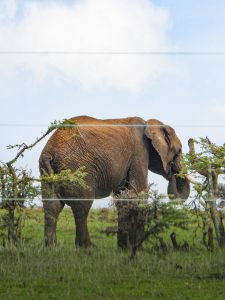

An African elephant near the West Laikipia Fence in Mutara Conservancy; A regular day in Laikipia with people, livestock and elephants coexisting in the same landscape.
Preparing for the field
Next up was the most challenging part: how do I actually get to Kenya and conduct the research? Despite the fact that my research group has worked in Kenya before, they had not worked specifically in my study region. This meant I would have to develop my own set of contacts there to plan the project. So I wrote multiple emails to multiple people across the globe who have worked in Laikipia before, and I was lucky enough to receive a very kind response from Marcia Van Eden from the US, who had conducted interviews with local communities there in 2016. Through her, I was able to get a set of contacts for Kenya and I finally managed to arrange my accommodation, travel, research equipments, as well as a local research assistant. There was also the issue of funding. Finland unfortunately has very few grants that fund research abroad during the Master’s degree, and the HiLife traineeship was the only grant I could actually apply to. So it really was a blessing to be able to receive this grant, and I would urge anyone reading this to apply for it too!
Jambo Kenya!
After months of planning, I finally made it to Kenya! The wildlife and the landscapes were exactly as stunning as I had imagined, and the people extremely kind and welcoming. As I had only around two months to finish interviewing three communities, I immediately set off to my study site to begin my research. For the first time in my life I saw zebras, giraffes and of course, African elephants! It was hard not to feel emotional during these moments. My assistant, Lucy, and I were lucky enough to be offered a place to stay at the ADC Mutara Ranch in Laikipia. From here, we travelled on motorbike every day to interview the communities, conducting a total of 188 interviews with farmers (and occasionally pastoralists) over the course of three weeks.
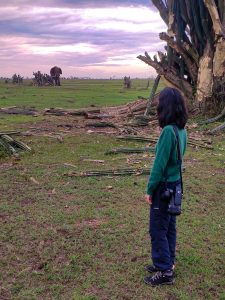
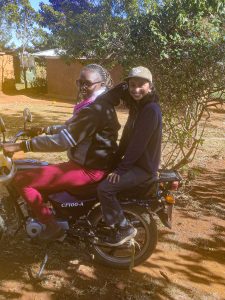
My first African elephant sighting; Lucy and me on our loyal motorbike that survived some of the worst terrains.
For me personally the best part of conducting this research was meeting the local people! Despite the fact that I was a stranger to them, each family opened their doors and welcomed me into their homes, many times even offering me warm tea and delicious food. And even though I was so far away, I still felt like I was at home.
 .
. 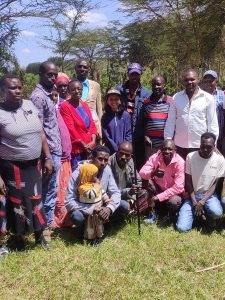
Happy faces; After a successful focused group discussion with the Mutara community.
Reflections
My study ultimately revealed that human-elephant conflict continues to be a persistent problem in Laikipia, with farmers often facing crop raids by elephants. Maize was the most frequently raided crop, and elephants mostly raided crops at night to minimise interactions with people. Community perceptions showed considerable changes over the years, revealing important insights for long-term fence effectiveness as well as elephant movement patterns in the region. One of the most significant results of my study was that higher involvement of local communities in electric fence management can lead to more positive community perceptions towards electric fences. I was also able to identify crop raiding hotspots in the target communities, and I found that the higher the diversity of crops grown in a given farm, the higher the chances of an elephant raiding it. My next step now is to submit a detailed report on all my findings to the various stakeholders involved in the establishment of the electric fences in my study region. For more details about my research, you can read my thesis at the following link: https://helda.helsinki.fi/items/c29c4de9-f1b7-4ecc-89de-041820cac57b
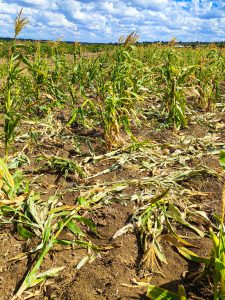
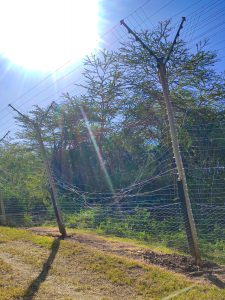
Damages by elephants to crops and electric fences.
Overall this project was an unforgettable learning experience for me both personally and professionally, and I’m very grateful to HiLIFE for helping me turn my dreams into reality. Signing off with a picture of a beautiful moment between a mother and her calf!

